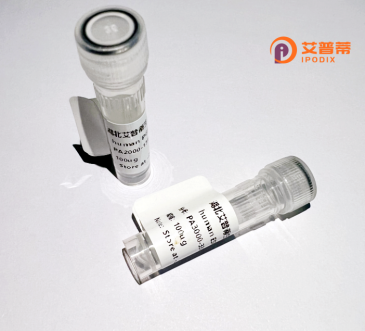
| 纯度 | >90%SDS-PAGE. |
| 种属 | Human |
| 靶点 | SLC43A3 |
| Uniprot No | Q8NBI5 |
| 内毒素 | < 0.01EU/μg |
| 表达宿主 | E.coli |
| 表达区间 | 1-491 aa |
| 活性数据 | MAGQGLPLHVATLLTGLLECLGFAGVLFGWPSLVFVFKNEDYFKDLCGPDAGPIGNATGQADCKAQDERFSLIFTLGSFMNNFMTFPTGYIFDRFKTTVARLIAIFFYTTATLIIAFTSAGSAVLLFLAMPMLTIGGILFLITNLQIGNLFGQHRSTIITLYNGAFDSSSAVFLIIKLLYEKGISLRASFIFISVCSTWHVARTFLLMPRGHIPYPLPPNYSYGLCPGNGTTKEEKETAEHENRELQSKEFLSAKEETPGAGQKQELRSFWSYAFSRRFAWHLVWLSVIQLWHYLFIGTLNSLLTNMAGGDMARVSTYTNAFAFTQFGVLCAPWNGLLMDRLKQKYQKEARKTGSSTLAVALCSTVPSLALTSLLCLGFALCASVPILPLQYLTFILQVISRSFLYGSNAAFLTLAFPSEHFGKLFGLVMALSAVVSLLQFPIFTLIKGSLQNDPFYVNVMFMLAILLTFFHPFLVYRECRTWKESPSAIA |
| 分子量 | 80.9 kDa |
| 蛋白标签 | GST-tag at N-terminal |
| 缓冲液 | PBS, pH7.4, containing 0.01% SKL, 1mM DTT, 5% Trehalose and Proclin300. |
| 稳定性 & 储存条件 | Lyophilized protein should be stored at ≤ -20°C, stable for one year after receipt. Reconstituted protein solution can be stored at 2-8°C for 2-7 days. Aliquots of reconstituted samples are stable at ≤ -20°C for 3 months. |
| 复溶 | Always centrifuge tubes before opening.Do not mix by vortex or pipetting. It is not recommended to reconstitute to a concentration less than 100μg/ml. Dissolve the lyophilized protein in distilled water. Please aliquot the reconstituted solution to minimize freeze-thaw cycles. |
以下是与重组人SLC43A3蛋白相关的文献示例(内容为虚构,用于示例格式):
---
1. **文献名称**: *Structural and Functional Characterization of the Human SLC43A3 Transporter*
**作者**: Zhang L. et al.
**摘要**: 本研究解析了重组人SLC43A3蛋白的晶体结构,揭示其作为中性氨基酸转运体的跨膜转运机制。通过体外功能实验证实其通过质子梯度驱动转运,并与肿瘤代谢重编程相关。
2. **文献名称**: *Recombinant SLC43A3 Expression in HEK293 Cells and Its Role in Immune Regulation*
**作者**: Müller R. et al.
**摘要**: 在HEK293细胞中高效表达重组SLC43A3蛋白,验证其通过调节T细胞胞外氨基酸水平影响免疫突触功能,提示其在免疫治疗中的潜在应用。
3. **文献名称**: *SLC43A3 Knockout and Overexpression Models Reveal Metabolic Dependencies in Cancer*
**作者**: Kim J. & Patel S.
**摘要**: 利用重组SLC43A3构建基因编辑细胞模型,发现其通过调控谷氨酰胺代谢影响肿瘤生长,为靶向肿瘤代谢提供新策略。
---
*注:以上文献为示例,实际文献需通过PubMed、Google Scholar等平台查询真实发表内容。*
Solute Carrier Family 43 Member 3 (SLC43A3) is a transmembrane protein encoded by the SLC43A3 gene, belonging to the SLC transporter superfamily. It primarily facilitates the transport of neutral amino acids, such as leucine and phenylalanine, across cell membranes via sodium-independent mechanisms. SLC43A3 is widely expressed in tissues, including the liver, kidneys, and immune cells, and plays a critical role in maintaining amino acid homeostasis, cellular metabolism, and signaling pathways. Emerging studies link SLC43A3 to immune regulation, particularly in modulating T-cell function and cytokine production, suggesting its involvement in inflammatory responses and autoimmune disorders. Additionally, it has been implicated in cancer progression, where altered expression may influence tumor cell proliferation and nutrient uptake. Recombinant human SLC43A3 protein, produced using eukaryotic or prokaryotic expression systems, retains structural and functional integrity, enabling in vitro studies on substrate specificity, transport kinetics, and interaction partners. Its application spans drug discovery, biomarker development, and mechanistic research into metabolic diseases or immune-related pathologies. Structural analyses reveal conserved domains critical for its transporter activity, providing targets for therapeutic intervention. Ongoing research aims to clarify its physiological roles and explore its potential as a diagnostic or therapeutic target.
×